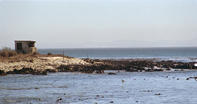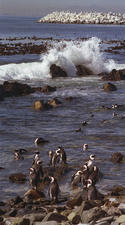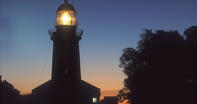The Boat Ride
I first visited Robben Island in 1989, as part of a special school tour. It was still a functioning prison back then, and my recollections are of a dark and dismal place where the miasma of despair hung thick in the salty air.

Now, Robben Island has been rehabilitated into a tourist attraction and the inmates have, literally, taken over the asylum. Accordingly, the hulking old ferry that used to lumber over the choppy seas to the small harbour on the island has been replaced by sleek, new, high-speed boats that whisk hordes of tourists to-and-fro in comfort.
The boat ride itself is remarkable for the breathtaking views that it offers of The Mountain and the city that squats at its feet. Once on the island, everybody clambers off the boat and onto one of two waiting busses. Like a well-oiled machine, the busses take you on a slightly frustrating journey around the island while the guide points out some of the famous sites, including the lime quarry where Mandela and his comrades hacked the days away.
It was here, in a small cavern carved out of the blinding white rock face, that the inmates ate their lunch and spoke about how things would be organised in a new, democratic South Africa. Some have since referred to the dark hidey-hole as the ‘classroom’ of Robben Island.
Watch the Penguins

When we returned to the main prison complex, I was glad to get off the bus and into the prison cells. Each guide on this part of the tour is a previous in-mate of the prison, and their recollections of life under the old regime are bitter-sweet. As we sat in one of the communal cells, our guide gave us quite a forthright and somewhat angry description of life as he knew it on Robben Island.
After the communal cell, we were lead to the prison courtyard where Mandela kept his small garden. And then came the main attraction: the row of single cells where Mandela and his fellow Rivonia Trialists were kept. A flurry of flash photography follows, and there is only time for a final debriefing in the toilets before you are released and sent back to the ship.
As you walk back to the harbour, you may take a stroll along the sponsored boardwalk to watch the penguins, or you may browse the extensive gift shop on the quayside.
At the appointed time, you will then climb on board for the return journey home, and watch with rueful irony as the next busload of voluntary inmates began their journey through the portals of Robben Island.
So, in many ways, Robben Island is a slick tourist machine, processing people like Disneyland during summer vacation.
In other ways, it is an important excursion that should be experienced by all South Africans so that we can better understand the traumatic realities of our history.
The V&A Waterfront
As a tourist, your journey to Robben Island begins at the Victoria and Alfred Waterfront. This is a busy retail hub, bursting with shops, restaurants, cinemas and Germans. The bustling complex sprawls over a large area and, depending on your proclivities, you can spend a good few hours browsing the shops before or after your trip to the island.
Originally an industrial dockyard and harbour for the city of Cape Town, the 19th century Waterfront area fell into disuse after larger docks were built on the Foreshore in the 20th century. Then, in 1988, the decaying warehouses were refurbished to create the sparkling new Waterfront that we enjoy today.
In addition to a large, enclosed shopping mall, called Victoria Wharf, the complex spreads across the Victoria Basin, offering fantastic harbour views. Pleasure cruises and helicopter flips are available, but none of these will take you to Robben Island.
Nelson Mandela Gateway

Make your way to the Nelson Mandela Gateway, where you will catch the Robben Island ferry. The Gateway and jetty are situated at the mouth of the compact Alfred Basin, where you will find several up-market hotels and private yachts, basking in the sun.
The view of Table Mountain from the Alfred Basin is marvellous. The Gateway also stands next to the Clock Tower, a bright-red landmark, and both are clearly signposted throughout the Waterfront.
If you park in one of the main parking lots near the mall, remember that you will have quite a long walk to the Gateway. But you’ll also have the pleasure of crossing a delicate swing bridge, which spans the narrow channel between the Alfred Basin and the sea.
The best place to park, therefore, is in the Clock Tower Centre, located on the far side of the Waterfront complex. This parkade is a little bit tricky to find, as it’s only accessible from the main roundabout near the city, but it will bring you out right at the Gateway building.
The Clock Tower Centre also contains dozens of shops and restaurants in its own right, and it has a large, well-staffed tourist information centre upstairs, with representatives from all over the country. This is an excellent source for information on Cape Town, the Western Cape and the whole of South Africa. The Info Centre has an internet café and you can book your tickets for the Robben Island tour at the desk.
By David Fleminger